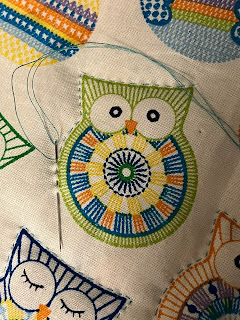Quilting requires some basic tools just like any other hobby. But this doesn't have to break the bank, and as you progress in your skills, you can buy more tools a little at a time. I do recommend starting with a smaller project - such as a baby quilt, lap quilt, wall hanging, or a pillow top.
Today, we'll start with simple tools for hand quilting. And we won't start by piecing a quilt, which would require a sewing machine. We can move into a machine-pieced quilt later on in this series.
- First, you'll need a pretty, 100% cotton print for the quilt top. The print should be a good size and easy to quilt around such as the cute owls in the picture below.
- You'll also need a 100% cotton backing fabric. If this is your first quilt, I recommend a solid backing. But if you're feeling brave, by all means select a coordinating print for the back side of your quilt.
- Batting is also required. Low-loft polyester batting is the least expensive and is easier to quilt through. If your budget allows, cotton batting is a good substitute for the low-loft polyester. Still, fleece can work just as effectively as either one of these other 2 choices. And fleece is often on sale at local craft shops, which may save you money as the center, unseen layer of your quilt.
- "Sharp" sewing needle.
- Hand-quilting or all-purpose thread.
- Quilting hoop (handheld or floor stand). A flat surface works fine as well if your budget doesn't allow for this right away.
- Spray basting to hold your quilt layers (top, batting, backing) together until the quilting is completed. No pins or basting stitches! This saves a lot of time and can be used for several quilting projects.
- In lieu of a thimble, I recommend using a Band-Aid on the tip of your "push" finger - the finger you will push the back end of the needle with.
- Scissors (cheapest but edges may not be straight) or a self-healing cutting mat (at least 36 inches), cutting ruler (at least 24 inches), and rotary cutting tool (45mm and replacement blades).
- Sewing clips.
Although the mat is not the size I recommend nor are there nearly enough sewing clips, above is an image of a sample of some of the tools I recommend. And although the size of the mat isn't my recommendation, this is a really good price if you want to start off with this little set. I've provided the link to that store below the image. Or look for another similar cutting set of your preference.
The store listed below the image does sell a cutting set with the recommended 36 inch mat size that I prefer. However, the price is significantly more. But the entire kit with the larger cutting mat costs about the same as 1 name-brand cutting mat in the local craft stores. So, in my opinion, it's still a good price since you also get the additional supplies in a kit like this. You can buy more clips and replacement cutting blades as needed. I have never used this product brand, but 85% out of 5,999 customers at the time of this posting have given the pictured kit a 5-star rating.
Get everything ready. In the next post, I'll provide instructions for you can make your first quilted print!
Questions? Just give me a shout.
#quilting
#womenhelpingwomen
#womenhelpingwomen
Warm hugs and blessings,
Patricia



Comments
Post a Comment
Thank you for taking time to leave a comment. Your comment will be published after it has been moderated. All SPAM is deleted by Blogger.